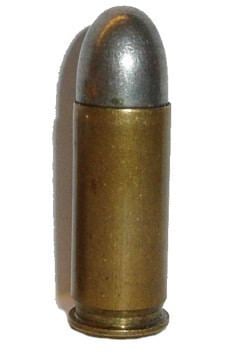Type Pistol | Place of origin United States Designed 1900 Case type Semi-rimmed, straight | |
 | ||
The .38 ACP (Automatic Colt Pistol) also known as the .38 Auto was introduced at the turn of the 20th century for the John Browning-designed Colt M1900. It was first used in Colt's Model 1897 prototype, which he did not produce. The metric designation for the round is 9×23mmSR (SR—Semi Rimmed) (not to be confused with the modern 9×23mm Winchester or the .380 ACP).
Contents
History
Initial loadings of this cartridge were quite powerful. Reported ballistics for the first commercial loads were a 130-grain bullet at 1,260 ft/s (380 m/s), and some experimental loads ran as high as 1,350 ft/s (410 m/s). However, these ballistics proved too violent for the Colt Model 1900 pistol, and velocities were soon lowered to below 1,200 ft/s (370 m/s). Subsequent commercial loadings varied considerably in power. For example, Captain Hugh B.C. Pollard, writing in Automatic Pistols published in 1920, gives Winchester factory ballistics for a 130-grain bullet at 1,175 ft/s (358 m/s) muzzle velocity and 398-foot-pound-force (540 J) of muzzle energy; for Ely ammo, the figures for a 128-grain bullet were 1,100 ft/s (340 m/s) and 344-foot-pound-force (466 J) and for Kynoch a 130-grain bullet 1,000 ft/s (300 m/s). Later U.S. commercial loads in this caliber had factory standard ballistics of a 130-grain bullet at 1,040 ft/s (320 m/s) from the 4.5-inch (110 mm) barrel of the Colt 1903 Pocket Model. With Army Ordnance favoring a return to a .45 caliber sidearm by the time the Colt autos in .38 ACP were introduced, the caliber never gained much popularity. However, they did see small but steady sales up until the introduction of the more powerful .38 Super, which was little more than the .38 ACP loaded back to its original ballistics.
Sales of .38 ACP ammunition enjoyed a modest spike during the surplus gun boom of the 1950s and 1960s, since the cartridges would usually cycle in Spanish surplus pistols like the Astra 400 that were chambered for the 9mm Bergmann–Bayard (9mm Largo), despite the fact that the .38 ACP was semi-rimmed and slightly shorter than the rimless 9 mm Largo. Some Astra 400 pistols were stamped "9M/M&38" on the barrel, denoting that the barrel was specifically designed to chamber both 9mm Largo and .38 ACP.
Europe would eventually favor the 9×19mm Parabellum cartridge. The Luger was ballistically similar to the .38 ACP but utilized a smaller case and higher pressures.
Browning himself was not done with 9mm cartridges and would soon introduce the 9mm Browning Long (9×20mm) in 1903 and the .380 ACP (9×17mm Short) in 1908.
